Analysis of Employee Turnover's Impact on Organizational Productivity
VerifiedAdded on 2022/08/22
|12
|2044
|15
Report
AI Summary
This report examines the impact of employee turnover on productivity within the automobile industry, employing a mixed-methods research approach including both qualitative and quantitative analyses. The study surveyed 50 employees, collecting demographic data and assessing factors influ...
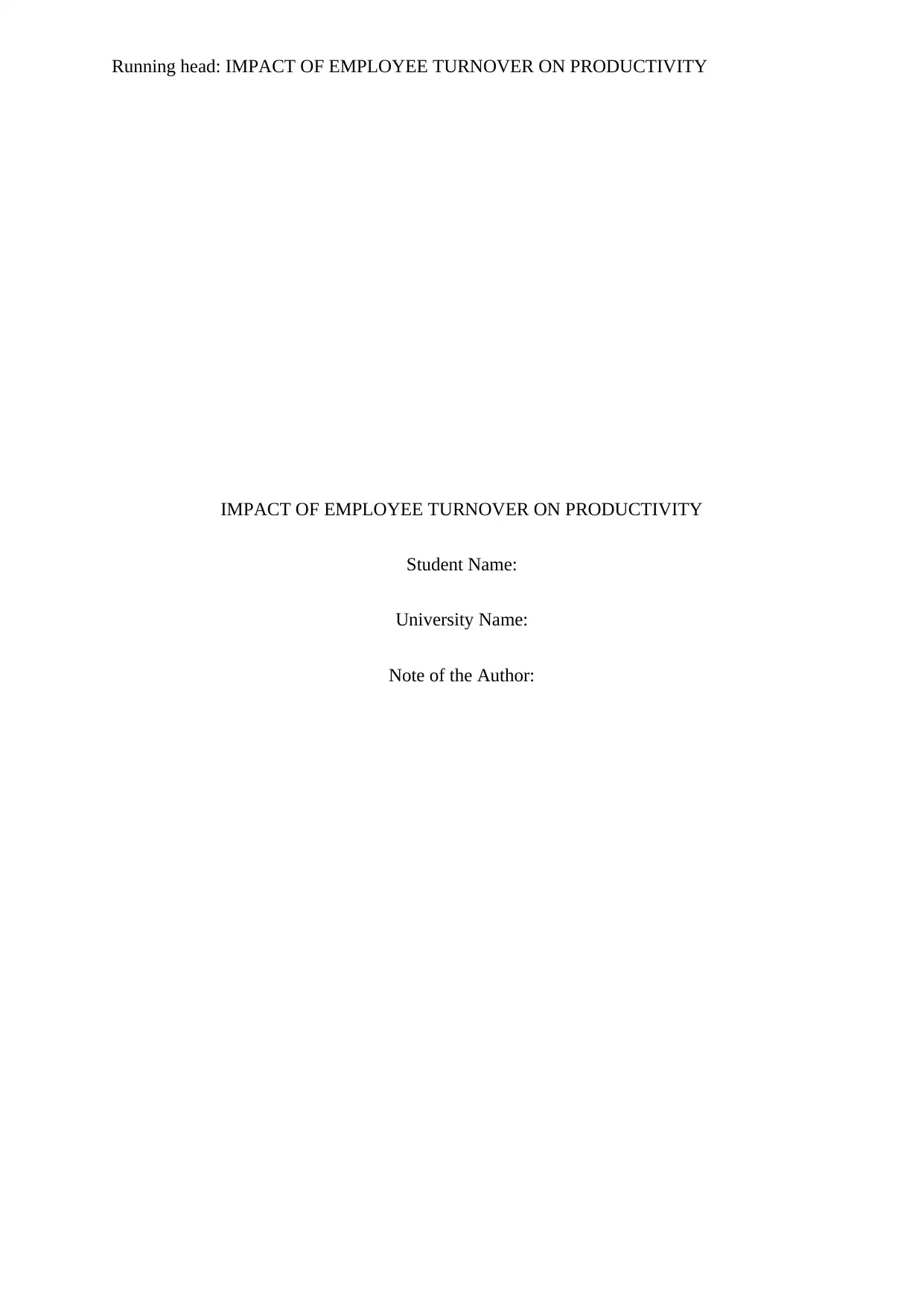
Running head: IMPACT OF EMPLOYEE TURNOVER ON PRODUCTIVITY
IMPACT OF EMPLOYEE TURNOVER ON PRODUCTIVITY
Student Name:
University Name:
Note of the Author:
IMPACT OF EMPLOYEE TURNOVER ON PRODUCTIVITY
Student Name:
University Name:
Note of the Author:
Paraphrase This Document
Need a fresh take? Get an instant paraphrase of this document with our AI Paraphraser
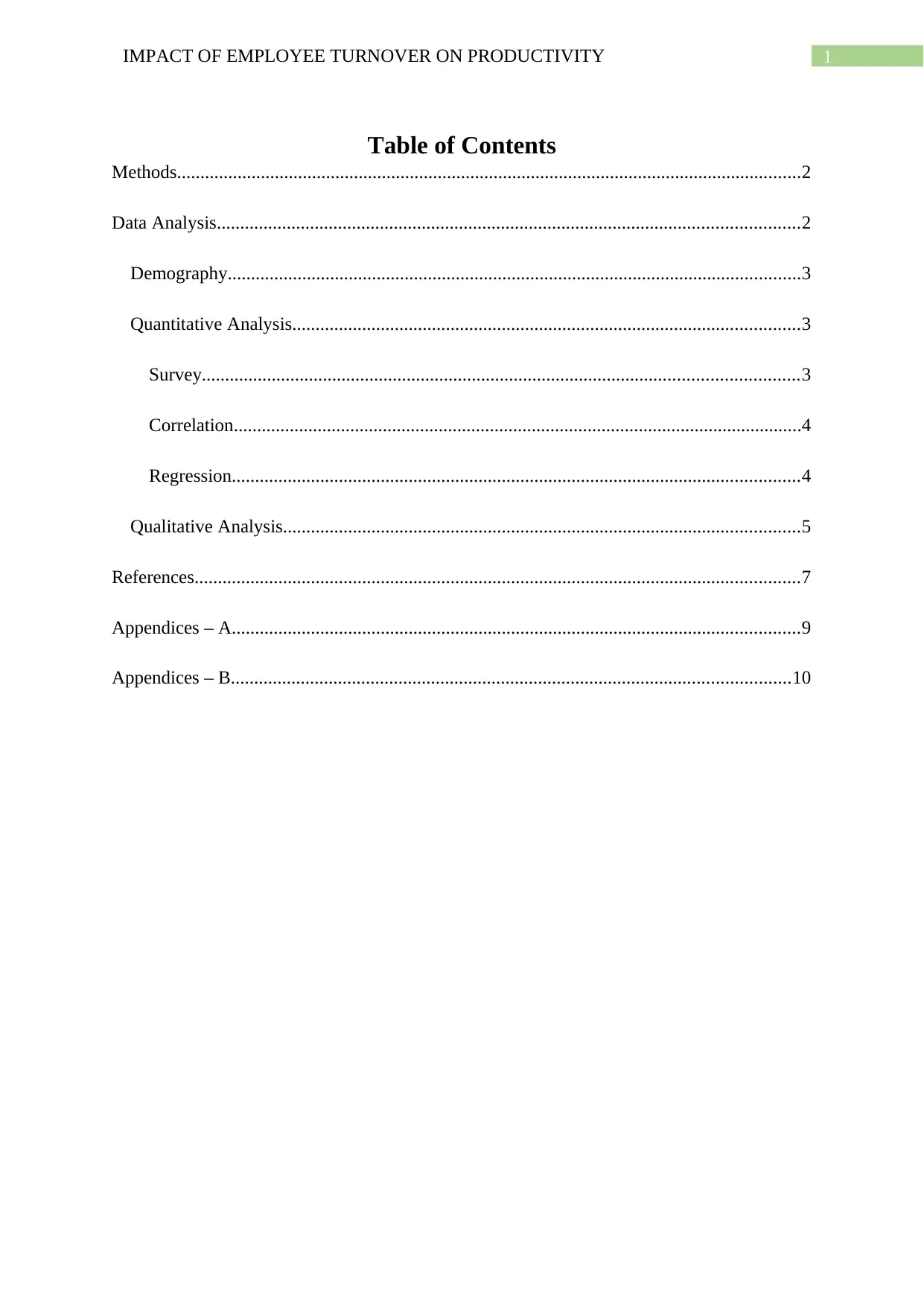
1IMPACT OF EMPLOYEE TURNOVER ON PRODUCTIVITY
Table of Contents
Methods......................................................................................................................................2
Data Analysis.............................................................................................................................2
Demography...........................................................................................................................3
Quantitative Analysis.............................................................................................................3
Survey................................................................................................................................3
Correlation..........................................................................................................................4
Regression..........................................................................................................................4
Qualitative Analysis...............................................................................................................5
References..................................................................................................................................7
Appendices – A..........................................................................................................................9
Appendices – B........................................................................................................................10
Table of Contents
Methods......................................................................................................................................2
Data Analysis.............................................................................................................................2
Demography...........................................................................................................................3
Quantitative Analysis.............................................................................................................3
Survey................................................................................................................................3
Correlation..........................................................................................................................4
Regression..........................................................................................................................4
Qualitative Analysis...............................................................................................................5
References..................................................................................................................................7
Appendices – A..........................................................................................................................9
Appendices – B........................................................................................................................10
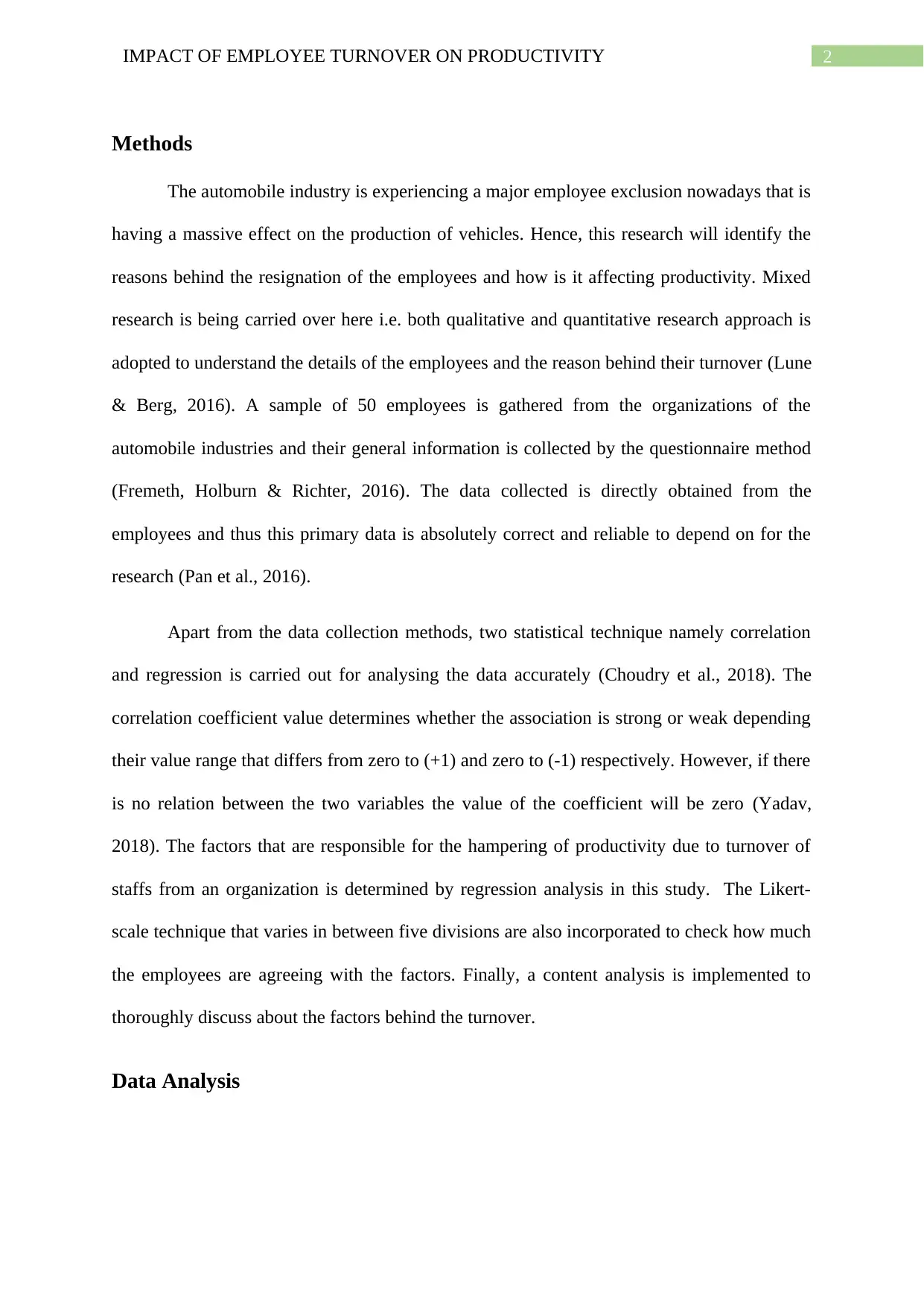
2IMPACT OF EMPLOYEE TURNOVER ON PRODUCTIVITY
Methods
The automobile industry is experiencing a major employee exclusion nowadays that is
having a massive effect on the production of vehicles. Hence, this research will identify the
reasons behind the resignation of the employees and how is it affecting productivity. Mixed
research is being carried over here i.e. both qualitative and quantitative research approach is
adopted to understand the details of the employees and the reason behind their turnover (Lune
& Berg, 2016). A sample of 50 employees is gathered from the organizations of the
automobile industries and their general information is collected by the questionnaire method
(Fremeth, Holburn & Richter, 2016). The data collected is directly obtained from the
employees and thus this primary data is absolutely correct and reliable to depend on for the
research (Pan et al., 2016).
Apart from the data collection methods, two statistical technique namely correlation
and regression is carried out for analysing the data accurately (Choudry et al., 2018). The
correlation coefficient value determines whether the association is strong or weak depending
their value range that differs from zero to (+1) and zero to (-1) respectively. However, if there
is no relation between the two variables the value of the coefficient will be zero (Yadav,
2018). The factors that are responsible for the hampering of productivity due to turnover of
staffs from an organization is determined by regression analysis in this study. The Likert-
scale technique that varies in between five divisions are also incorporated to check how much
the employees are agreeing with the factors. Finally, a content analysis is implemented to
thoroughly discuss about the factors behind the turnover.
Data Analysis
Methods
The automobile industry is experiencing a major employee exclusion nowadays that is
having a massive effect on the production of vehicles. Hence, this research will identify the
reasons behind the resignation of the employees and how is it affecting productivity. Mixed
research is being carried over here i.e. both qualitative and quantitative research approach is
adopted to understand the details of the employees and the reason behind their turnover (Lune
& Berg, 2016). A sample of 50 employees is gathered from the organizations of the
automobile industries and their general information is collected by the questionnaire method
(Fremeth, Holburn & Richter, 2016). The data collected is directly obtained from the
employees and thus this primary data is absolutely correct and reliable to depend on for the
research (Pan et al., 2016).
Apart from the data collection methods, two statistical technique namely correlation
and regression is carried out for analysing the data accurately (Choudry et al., 2018). The
correlation coefficient value determines whether the association is strong or weak depending
their value range that differs from zero to (+1) and zero to (-1) respectively. However, if there
is no relation between the two variables the value of the coefficient will be zero (Yadav,
2018). The factors that are responsible for the hampering of productivity due to turnover of
staffs from an organization is determined by regression analysis in this study. The Likert-
scale technique that varies in between five divisions are also incorporated to check how much
the employees are agreeing with the factors. Finally, a content analysis is implemented to
thoroughly discuss about the factors behind the turnover.
Data Analysis
You're viewing a preview
Unlock full access by subscribing today!
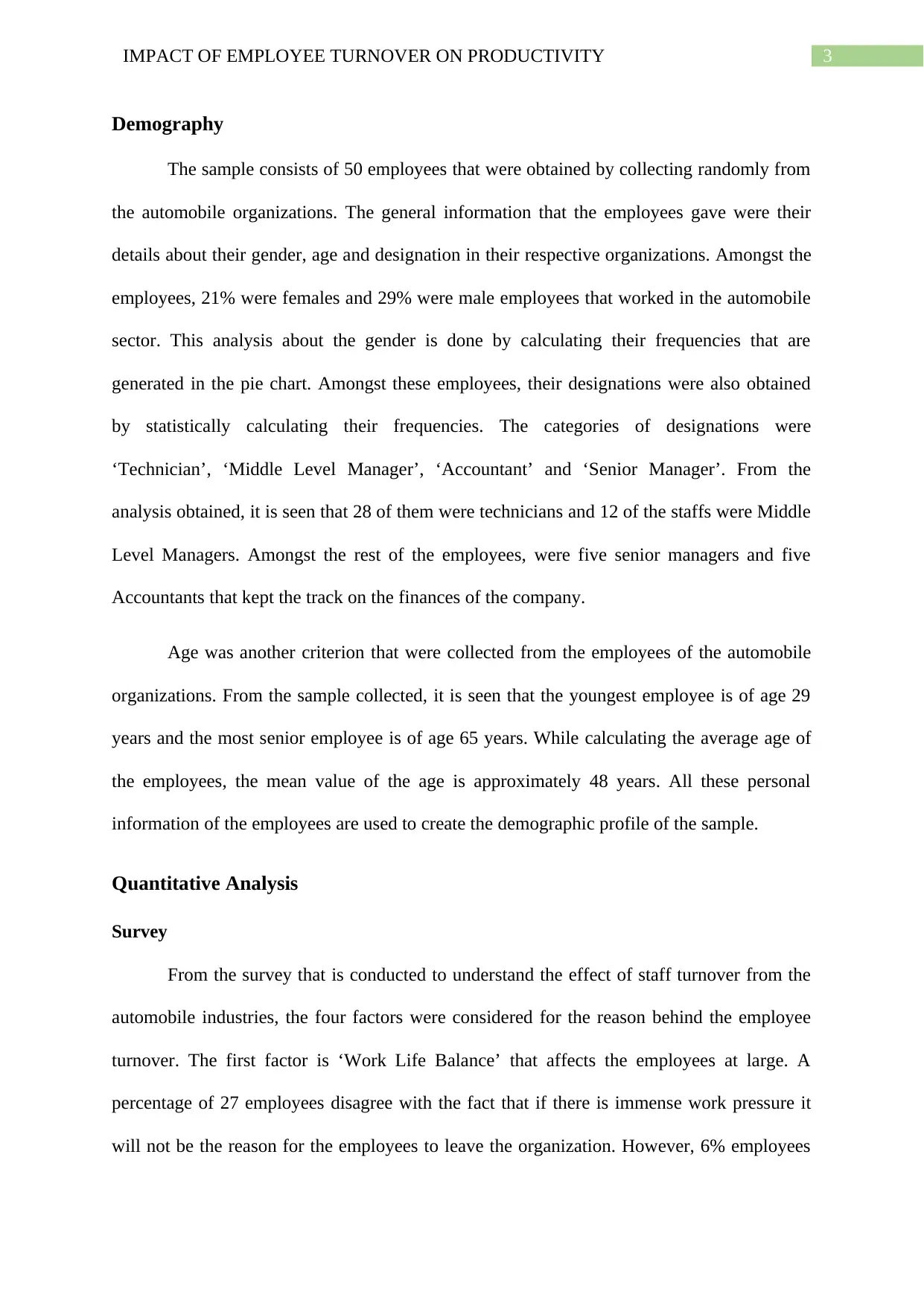
3IMPACT OF EMPLOYEE TURNOVER ON PRODUCTIVITY
Demography
The sample consists of 50 employees that were obtained by collecting randomly from
the automobile organizations. The general information that the employees gave were their
details about their gender, age and designation in their respective organizations. Amongst the
employees, 21% were females and 29% were male employees that worked in the automobile
sector. This analysis about the gender is done by calculating their frequencies that are
generated in the pie chart. Amongst these employees, their designations were also obtained
by statistically calculating their frequencies. The categories of designations were
‘Technician’, ‘Middle Level Manager’, ‘Accountant’ and ‘Senior Manager’. From the
analysis obtained, it is seen that 28 of them were technicians and 12 of the staffs were Middle
Level Managers. Amongst the rest of the employees, were five senior managers and five
Accountants that kept the track on the finances of the company.
Age was another criterion that were collected from the employees of the automobile
organizations. From the sample collected, it is seen that the youngest employee is of age 29
years and the most senior employee is of age 65 years. While calculating the average age of
the employees, the mean value of the age is approximately 48 years. All these personal
information of the employees are used to create the demographic profile of the sample.
Quantitative Analysis
Survey
From the survey that is conducted to understand the effect of staff turnover from the
automobile industries, the four factors were considered for the reason behind the employee
turnover. The first factor is ‘Work Life Balance’ that affects the employees at large. A
percentage of 27 employees disagree with the fact that if there is immense work pressure it
will not be the reason for the employees to leave the organization. However, 6% employees
Demography
The sample consists of 50 employees that were obtained by collecting randomly from
the automobile organizations. The general information that the employees gave were their
details about their gender, age and designation in their respective organizations. Amongst the
employees, 21% were females and 29% were male employees that worked in the automobile
sector. This analysis about the gender is done by calculating their frequencies that are
generated in the pie chart. Amongst these employees, their designations were also obtained
by statistically calculating their frequencies. The categories of designations were
‘Technician’, ‘Middle Level Manager’, ‘Accountant’ and ‘Senior Manager’. From the
analysis obtained, it is seen that 28 of them were technicians and 12 of the staffs were Middle
Level Managers. Amongst the rest of the employees, were five senior managers and five
Accountants that kept the track on the finances of the company.
Age was another criterion that were collected from the employees of the automobile
organizations. From the sample collected, it is seen that the youngest employee is of age 29
years and the most senior employee is of age 65 years. While calculating the average age of
the employees, the mean value of the age is approximately 48 years. All these personal
information of the employees are used to create the demographic profile of the sample.
Quantitative Analysis
Survey
From the survey that is conducted to understand the effect of staff turnover from the
automobile industries, the four factors were considered for the reason behind the employee
turnover. The first factor is ‘Work Life Balance’ that affects the employees at large. A
percentage of 27 employees disagree with the fact that if there is immense work pressure it
will not be the reason for the employees to leave the organization. However, 6% employees
Paraphrase This Document
Need a fresh take? Get an instant paraphrase of this document with our AI Paraphraser
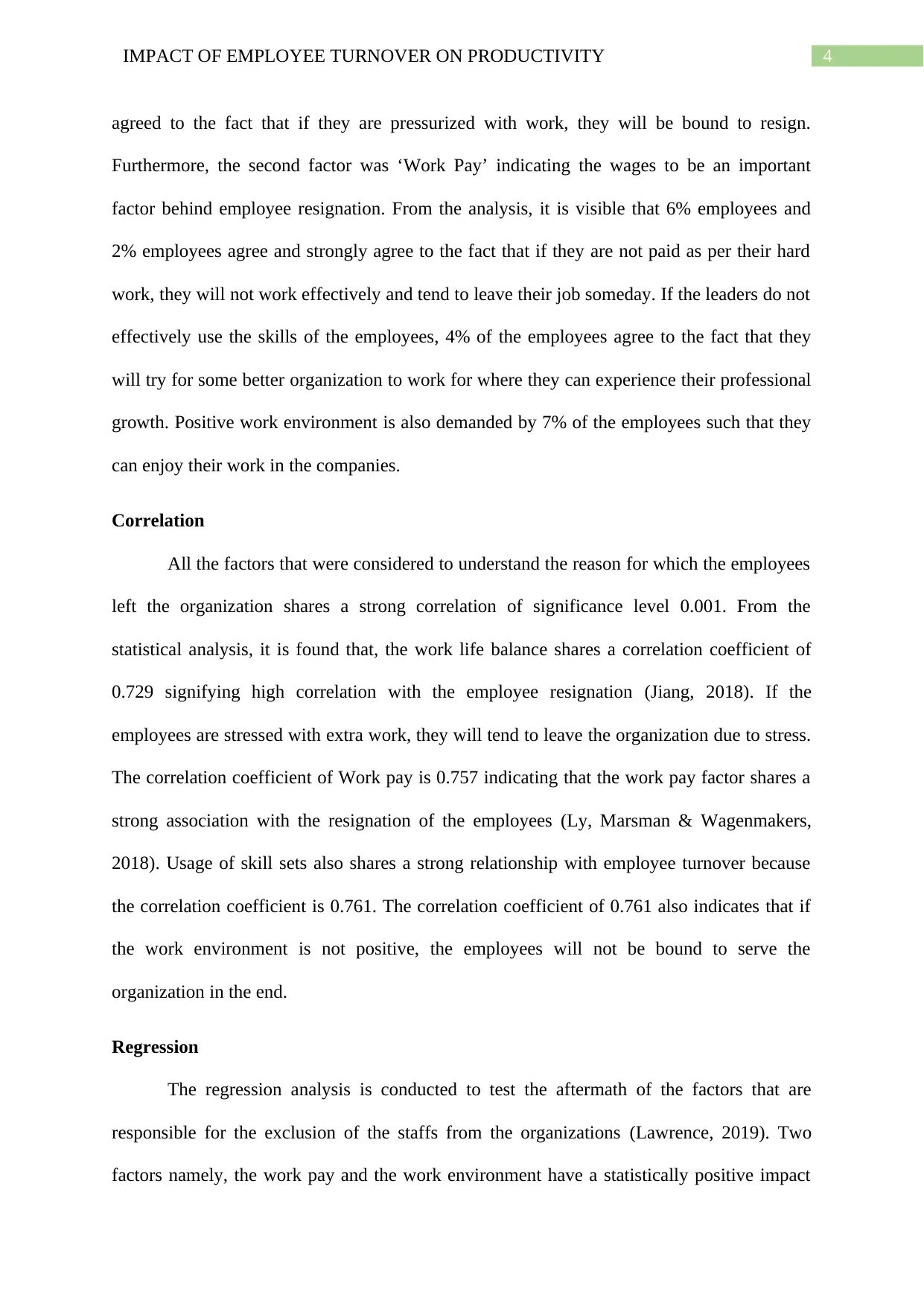
4IMPACT OF EMPLOYEE TURNOVER ON PRODUCTIVITY
agreed to the fact that if they are pressurized with work, they will be bound to resign.
Furthermore, the second factor was ‘Work Pay’ indicating the wages to be an important
factor behind employee resignation. From the analysis, it is visible that 6% employees and
2% employees agree and strongly agree to the fact that if they are not paid as per their hard
work, they will not work effectively and tend to leave their job someday. If the leaders do not
effectively use the skills of the employees, 4% of the employees agree to the fact that they
will try for some better organization to work for where they can experience their professional
growth. Positive work environment is also demanded by 7% of the employees such that they
can enjoy their work in the companies.
Correlation
All the factors that were considered to understand the reason for which the employees
left the organization shares a strong correlation of significance level 0.001. From the
statistical analysis, it is found that, the work life balance shares a correlation coefficient of
0.729 signifying high correlation with the employee resignation (Jiang, 2018). If the
employees are stressed with extra work, they will tend to leave the organization due to stress.
The correlation coefficient of Work pay is 0.757 indicating that the work pay factor shares a
strong association with the resignation of the employees (Ly, Marsman & Wagenmakers,
2018). Usage of skill sets also shares a strong relationship with employee turnover because
the correlation coefficient is 0.761. The correlation coefficient of 0.761 also indicates that if
the work environment is not positive, the employees will not be bound to serve the
organization in the end.
Regression
The regression analysis is conducted to test the aftermath of the factors that are
responsible for the exclusion of the staffs from the organizations (Lawrence, 2019). Two
factors namely, the work pay and the work environment have a statistically positive impact
agreed to the fact that if they are pressurized with work, they will be bound to resign.
Furthermore, the second factor was ‘Work Pay’ indicating the wages to be an important
factor behind employee resignation. From the analysis, it is visible that 6% employees and
2% employees agree and strongly agree to the fact that if they are not paid as per their hard
work, they will not work effectively and tend to leave their job someday. If the leaders do not
effectively use the skills of the employees, 4% of the employees agree to the fact that they
will try for some better organization to work for where they can experience their professional
growth. Positive work environment is also demanded by 7% of the employees such that they
can enjoy their work in the companies.
Correlation
All the factors that were considered to understand the reason for which the employees
left the organization shares a strong correlation of significance level 0.001. From the
statistical analysis, it is found that, the work life balance shares a correlation coefficient of
0.729 signifying high correlation with the employee resignation (Jiang, 2018). If the
employees are stressed with extra work, they will tend to leave the organization due to stress.
The correlation coefficient of Work pay is 0.757 indicating that the work pay factor shares a
strong association with the resignation of the employees (Ly, Marsman & Wagenmakers,
2018). Usage of skill sets also shares a strong relationship with employee turnover because
the correlation coefficient is 0.761. The correlation coefficient of 0.761 also indicates that if
the work environment is not positive, the employees will not be bound to serve the
organization in the end.
Regression
The regression analysis is conducted to test the aftermath of the factors that are
responsible for the exclusion of the staffs from the organizations (Lawrence, 2019). Two
factors namely, the work pay and the work environment have a statistically positive impact
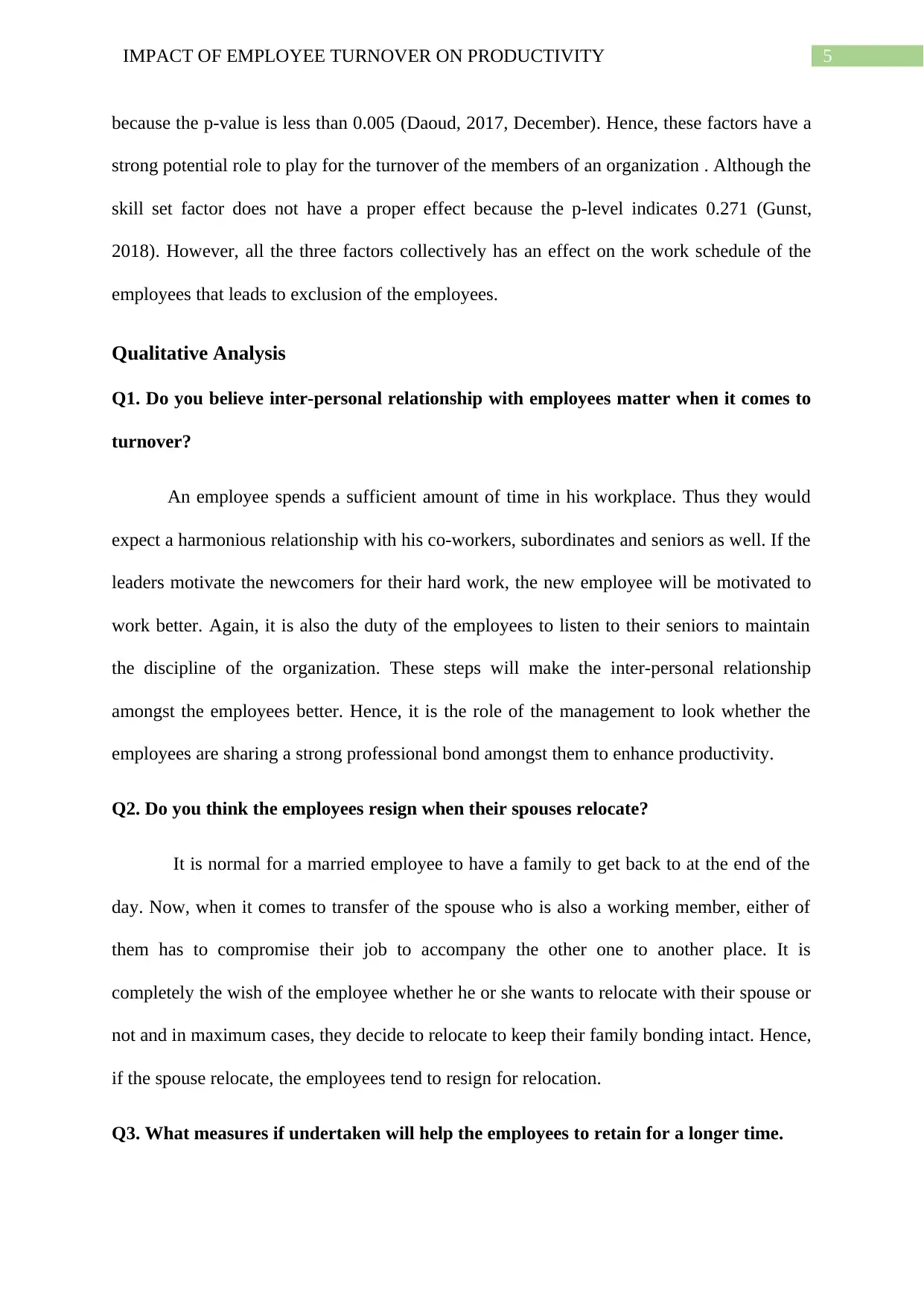
5IMPACT OF EMPLOYEE TURNOVER ON PRODUCTIVITY
because the p-value is less than 0.005 (Daoud, 2017, December). Hence, these factors have a
strong potential role to play for the turnover of the members of an organization . Although the
skill set factor does not have a proper effect because the p-level indicates 0.271 (Gunst,
2018). However, all the three factors collectively has an effect on the work schedule of the
employees that leads to exclusion of the employees.
Qualitative Analysis
Q1. Do you believe inter-personal relationship with employees matter when it comes to
turnover?
An employee spends a sufficient amount of time in his workplace. Thus they would
expect a harmonious relationship with his co-workers, subordinates and seniors as well. If the
leaders motivate the newcomers for their hard work, the new employee will be motivated to
work better. Again, it is also the duty of the employees to listen to their seniors to maintain
the discipline of the organization. These steps will make the inter-personal relationship
amongst the employees better. Hence, it is the role of the management to look whether the
employees are sharing a strong professional bond amongst them to enhance productivity.
Q2. Do you think the employees resign when their spouses relocate?
It is normal for a married employee to have a family to get back to at the end of the
day. Now, when it comes to transfer of the spouse who is also a working member, either of
them has to compromise their job to accompany the other one to another place. It is
completely the wish of the employee whether he or she wants to relocate with their spouse or
not and in maximum cases, they decide to relocate to keep their family bonding intact. Hence,
if the spouse relocate, the employees tend to resign for relocation.
Q3. What measures if undertaken will help the employees to retain for a longer time.
because the p-value is less than 0.005 (Daoud, 2017, December). Hence, these factors have a
strong potential role to play for the turnover of the members of an organization . Although the
skill set factor does not have a proper effect because the p-level indicates 0.271 (Gunst,
2018). However, all the three factors collectively has an effect on the work schedule of the
employees that leads to exclusion of the employees.
Qualitative Analysis
Q1. Do you believe inter-personal relationship with employees matter when it comes to
turnover?
An employee spends a sufficient amount of time in his workplace. Thus they would
expect a harmonious relationship with his co-workers, subordinates and seniors as well. If the
leaders motivate the newcomers for their hard work, the new employee will be motivated to
work better. Again, it is also the duty of the employees to listen to their seniors to maintain
the discipline of the organization. These steps will make the inter-personal relationship
amongst the employees better. Hence, it is the role of the management to look whether the
employees are sharing a strong professional bond amongst them to enhance productivity.
Q2. Do you think the employees resign when their spouses relocate?
It is normal for a married employee to have a family to get back to at the end of the
day. Now, when it comes to transfer of the spouse who is also a working member, either of
them has to compromise their job to accompany the other one to another place. It is
completely the wish of the employee whether he or she wants to relocate with their spouse or
not and in maximum cases, they decide to relocate to keep their family bonding intact. Hence,
if the spouse relocate, the employees tend to resign for relocation.
Q3. What measures if undertaken will help the employees to retain for a longer time.
You're viewing a preview
Unlock full access by subscribing today!
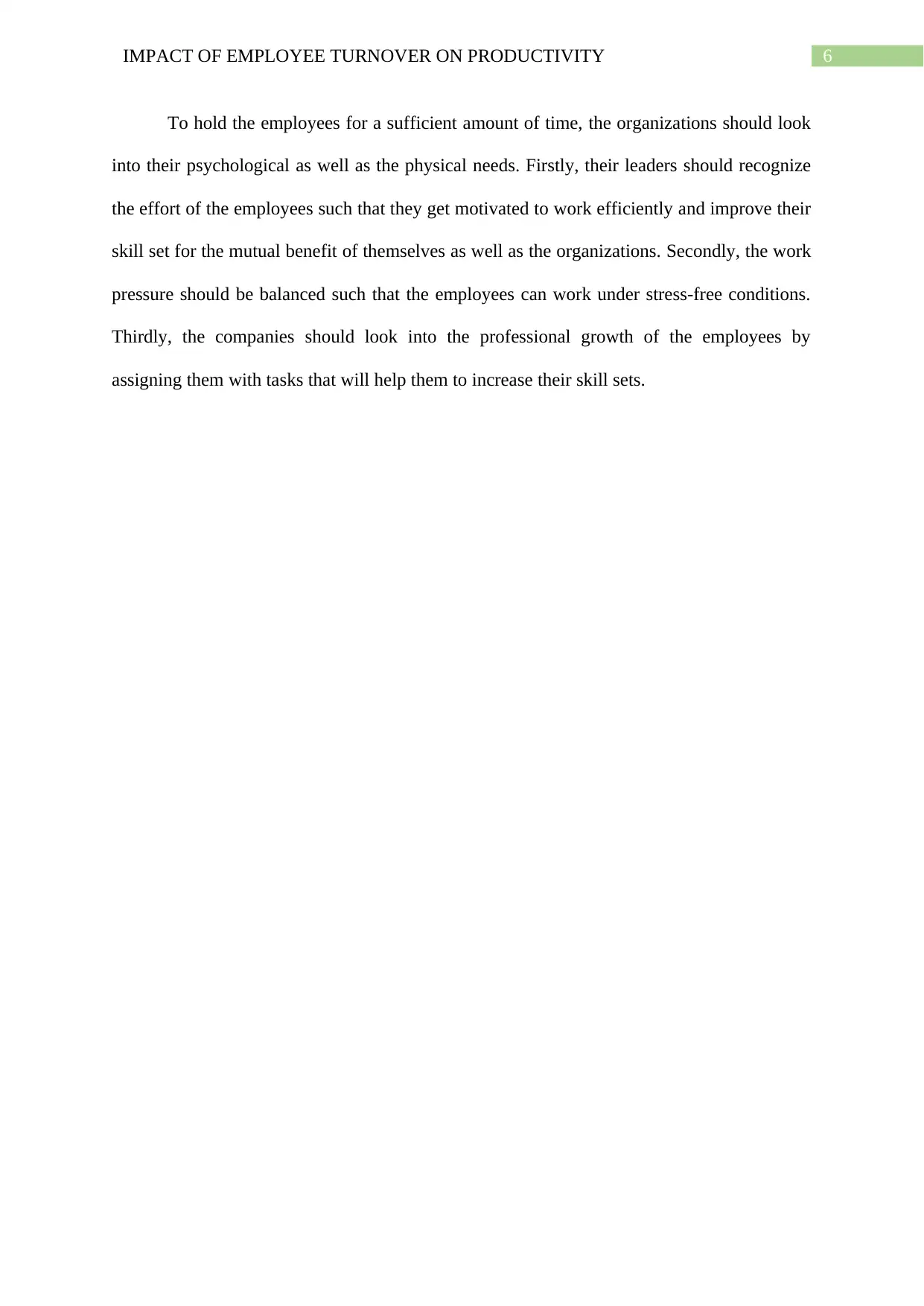
6IMPACT OF EMPLOYEE TURNOVER ON PRODUCTIVITY
To hold the employees for a sufficient amount of time, the organizations should look
into their psychological as well as the physical needs. Firstly, their leaders should recognize
the effort of the employees such that they get motivated to work efficiently and improve their
skill set for the mutual benefit of themselves as well as the organizations. Secondly, the work
pressure should be balanced such that the employees can work under stress-free conditions.
Thirdly, the companies should look into the professional growth of the employees by
assigning them with tasks that will help them to increase their skill sets.
To hold the employees for a sufficient amount of time, the organizations should look
into their psychological as well as the physical needs. Firstly, their leaders should recognize
the effort of the employees such that they get motivated to work efficiently and improve their
skill set for the mutual benefit of themselves as well as the organizations. Secondly, the work
pressure should be balanced such that the employees can work under stress-free conditions.
Thirdly, the companies should look into the professional growth of the employees by
assigning them with tasks that will help them to increase their skill sets.
Paraphrase This Document
Need a fresh take? Get an instant paraphrase of this document with our AI Paraphraser
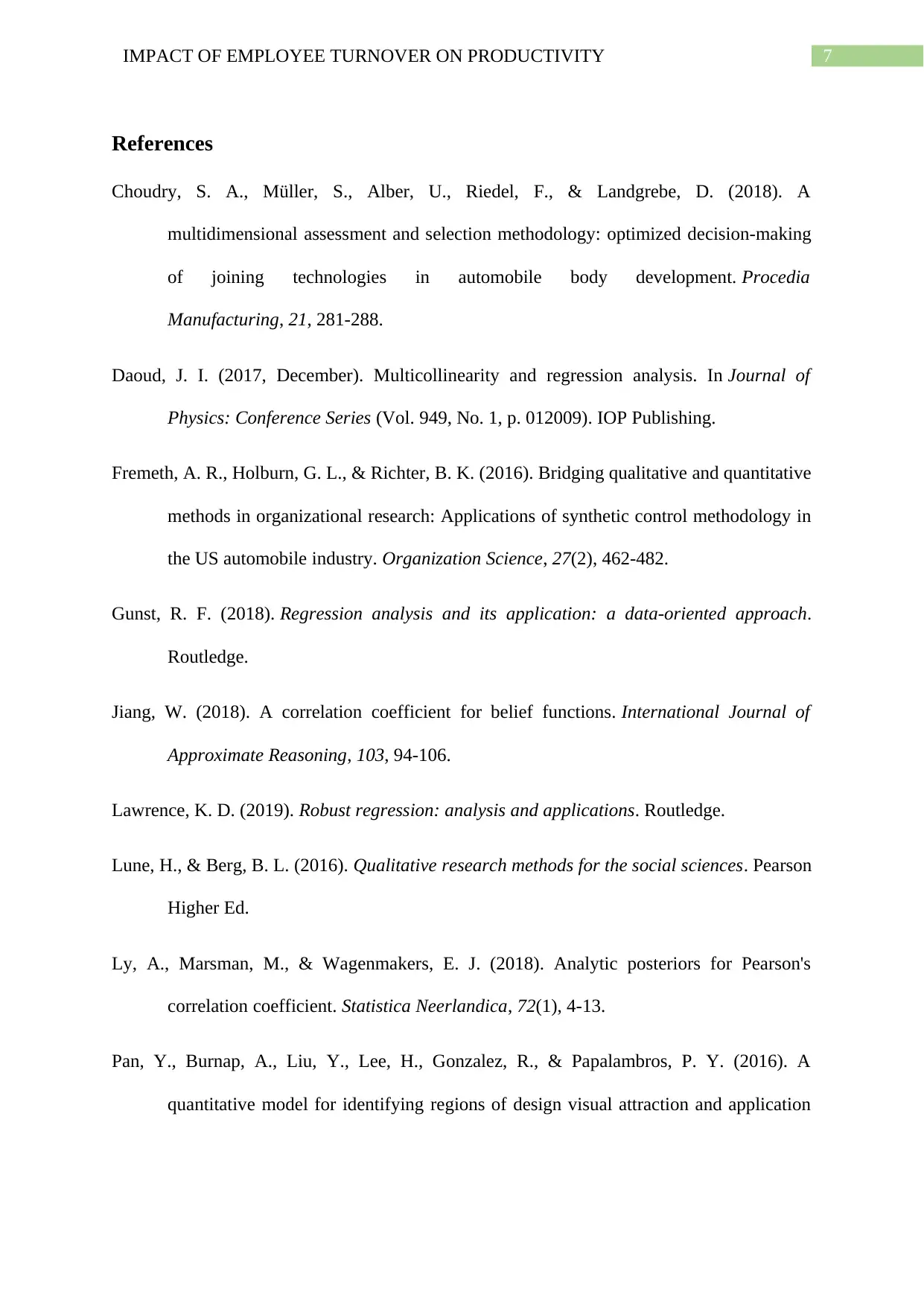
7IMPACT OF EMPLOYEE TURNOVER ON PRODUCTIVITY
References
Choudry, S. A., Müller, S., Alber, U., Riedel, F., & Landgrebe, D. (2018). A
multidimensional assessment and selection methodology: optimized decision-making
of joining technologies in automobile body development. Procedia
Manufacturing, 21, 281-288.
Daoud, J. I. (2017, December). Multicollinearity and regression analysis. In Journal of
Physics: Conference Series (Vol. 949, No. 1, p. 012009). IOP Publishing.
Fremeth, A. R., Holburn, G. L., & Richter, B. K. (2016). Bridging qualitative and quantitative
methods in organizational research: Applications of synthetic control methodology in
the US automobile industry. Organization Science, 27(2), 462-482.
Gunst, R. F. (2018). Regression analysis and its application: a data-oriented approach.
Routledge.
Jiang, W. (2018). A correlation coefficient for belief functions. International Journal of
Approximate Reasoning, 103, 94-106.
Lawrence, K. D. (2019). Robust regression: analysis and applications. Routledge.
Lune, H., & Berg, B. L. (2016). Qualitative research methods for the social sciences. Pearson
Higher Ed.
Ly, A., Marsman, M., & Wagenmakers, E. J. (2018). Analytic posteriors for Pearson's
correlation coefficient. Statistica Neerlandica, 72(1), 4-13.
Pan, Y., Burnap, A., Liu, Y., Lee, H., Gonzalez, R., & Papalambros, P. Y. (2016). A
quantitative model for identifying regions of design visual attraction and application
References
Choudry, S. A., Müller, S., Alber, U., Riedel, F., & Landgrebe, D. (2018). A
multidimensional assessment and selection methodology: optimized decision-making
of joining technologies in automobile body development. Procedia
Manufacturing, 21, 281-288.
Daoud, J. I. (2017, December). Multicollinearity and regression analysis. In Journal of
Physics: Conference Series (Vol. 949, No. 1, p. 012009). IOP Publishing.
Fremeth, A. R., Holburn, G. L., & Richter, B. K. (2016). Bridging qualitative and quantitative
methods in organizational research: Applications of synthetic control methodology in
the US automobile industry. Organization Science, 27(2), 462-482.
Gunst, R. F. (2018). Regression analysis and its application: a data-oriented approach.
Routledge.
Jiang, W. (2018). A correlation coefficient for belief functions. International Journal of
Approximate Reasoning, 103, 94-106.
Lawrence, K. D. (2019). Robust regression: analysis and applications. Routledge.
Lune, H., & Berg, B. L. (2016). Qualitative research methods for the social sciences. Pearson
Higher Ed.
Ly, A., Marsman, M., & Wagenmakers, E. J. (2018). Analytic posteriors for Pearson's
correlation coefficient. Statistica Neerlandica, 72(1), 4-13.
Pan, Y., Burnap, A., Liu, Y., Lee, H., Gonzalez, R., & Papalambros, P. Y. (2016). A
quantitative model for identifying regions of design visual attraction and application
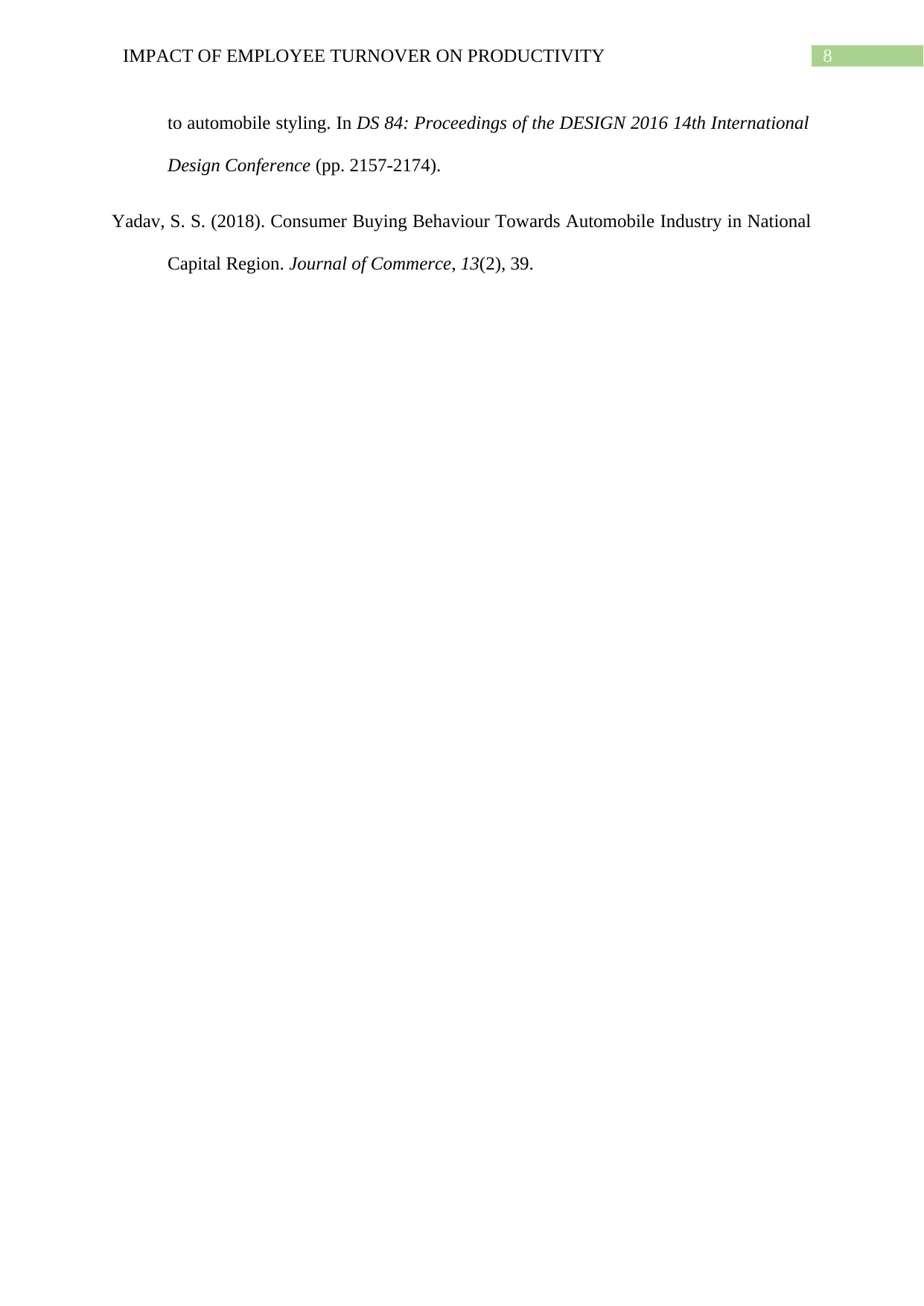
8IMPACT OF EMPLOYEE TURNOVER ON PRODUCTIVITY
to automobile styling. In DS 84: Proceedings of the DESIGN 2016 14th International
Design Conference (pp. 2157-2174).
Yadav, S. S. (2018). Consumer Buying Behaviour Towards Automobile Industry in National
Capital Region. Journal of Commerce, 13(2), 39.
to automobile styling. In DS 84: Proceedings of the DESIGN 2016 14th International
Design Conference (pp. 2157-2174).
Yadav, S. S. (2018). Consumer Buying Behaviour Towards Automobile Industry in National
Capital Region. Journal of Commerce, 13(2), 39.
You're viewing a preview
Unlock full access by subscribing today!

9IMPACT OF EMPLOYEE TURNOVER ON PRODUCTIVITY
Appendices – A
Quantitative
Section 1: General Information
Gender Male Female
Designation Technician
Middle Level
Manager Accountant
Senior
Manager
Section 2: Factors influencing high turnover of employee
Is the work life balance promoted and practiced in the
company? SD D N A SA
Is the work pay adequate in relation to the responsibility? SD D N A SA
Are the skills of the employees in the company effectively
used? SD D N A SA
Is the work environment in the company positive? SD D N A SA
Qualitative
Do you believe inter-personal relationship with employees matter when it comes to
turnover?
Do you think the employees resign when their spouses relocate?
What measures if undertaken will help the employees to retain for a longer time.
Appendices – A
Quantitative
Section 1: General Information
Gender Male Female
Designation Technician
Middle Level
Manager Accountant
Senior
Manager
Section 2: Factors influencing high turnover of employee
Is the work life balance promoted and practiced in the
company? SD D N A SA
Is the work pay adequate in relation to the responsibility? SD D N A SA
Are the skills of the employees in the company effectively
used? SD D N A SA
Is the work environment in the company positive? SD D N A SA
Qualitative
Do you believe inter-personal relationship with employees matter when it comes to
turnover?
Do you think the employees resign when their spouses relocate?
What measures if undertaken will help the employees to retain for a longer time.
Paraphrase This Document
Need a fresh take? Get an instant paraphrase of this document with our AI Paraphraser
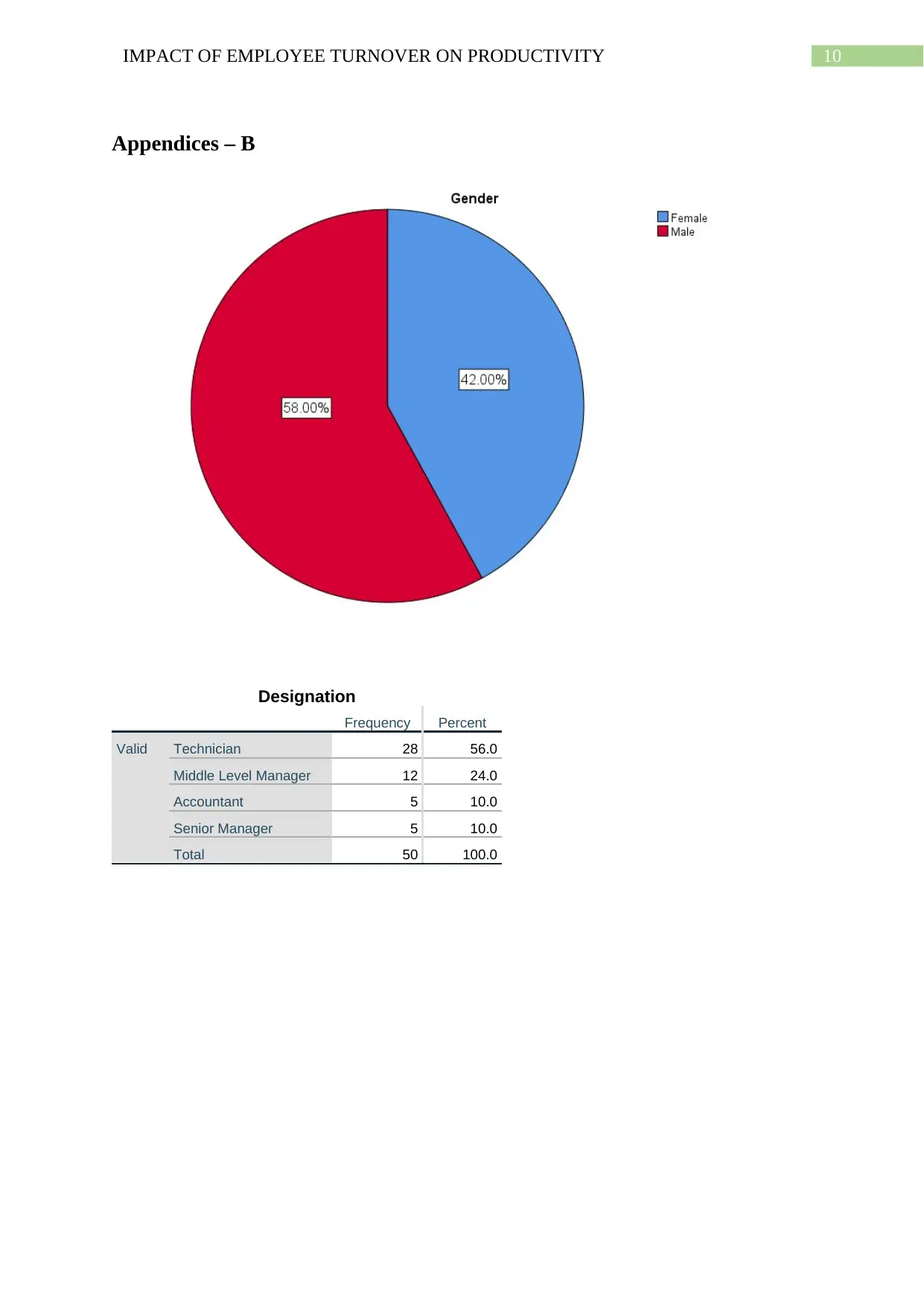
10IMPACT OF EMPLOYEE TURNOVER ON PRODUCTIVITY
Appendices – B
Designation
Frequency Percent
Valid Technician 28 56.0
Middle Level Manager 12 24.0
Accountant 5 10.0
Senior Manager 5 10.0
Total 50 100.0
Appendices – B
Designation
Frequency Percent
Valid Technician 28 56.0
Middle Level Manager 12 24.0
Accountant 5 10.0
Senior Manager 5 10.0
Total 50 100.0
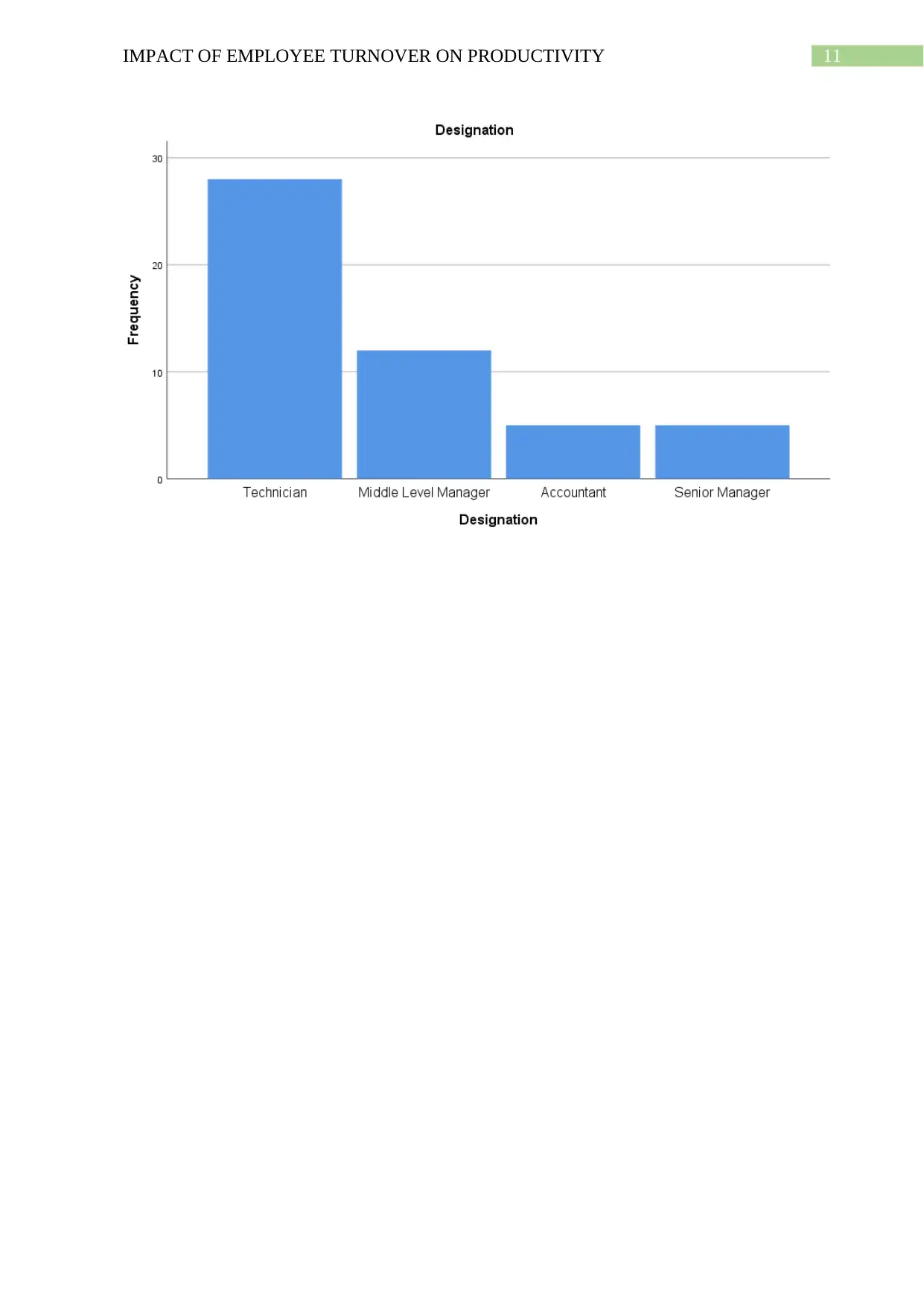
11IMPACT OF EMPLOYEE TURNOVER ON PRODUCTIVITY
You're viewing a preview
Unlock full access by subscribing today!
1 out of 12
Related Documents
Your All-in-One AI-Powered Toolkit for Academic Success.
+13062052269
info@desklib.com
Available 24*7 on WhatsApp / Email
![[object Object]](/_next/static/media/star-bottom.7253800d.svg)
Unlock your academic potential
© 2024 | Zucol Services PVT LTD | All rights reserved.



![Retail Grocery Customer Satisfaction Analysis Report - [University]](/_next/image/?url=https%3A%2F%2Fdesklib.com%2Fmedia%2Fimages%2Fbv%2Fb8a73bdc393b4353b49353de50973546.jpg&w=256&q=75)

